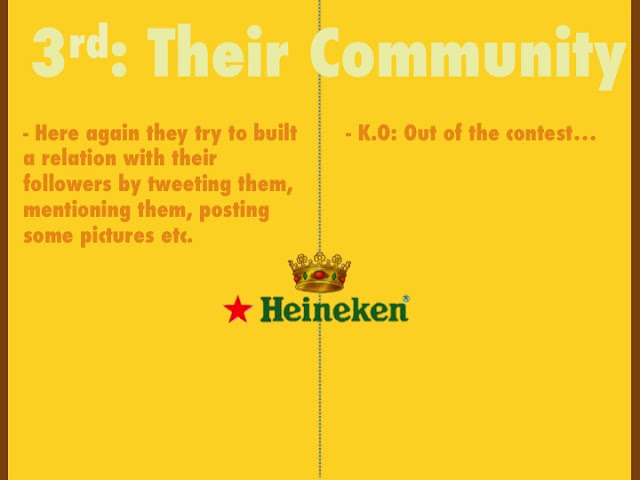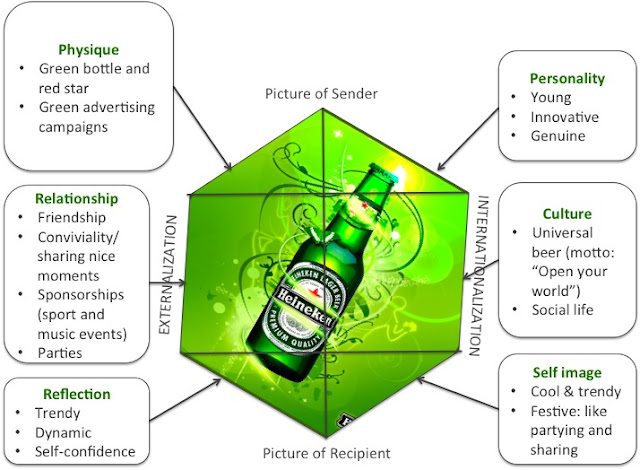Product:
On the one hand, the taste of Heineken never changes ; it has
a mildly bitter taste, fresh fruity aroma, a bight color and clarity that are
obtained using only the purest water, hops and barley malt.
On the other hand, 1664 has golden hues and
delicate bitterness that come from selecting the best hops (the Strisselspalt). Strisselspalt is also named the "caviar of hops" for its low bitterness and
aromatic qualities. Its specific soil and culture technique requirements make
it rare and quite unique to the Alsace Region.
The two brands in France are available in three different containers:
- Cans
- Bottle
DraughtKeg: an interesting fact about it: it is a 5lt keg that has the entire tapping
system built into it. The keg is portable disposable, 100% recyclable and manufactured in lightweight steel. Heineken first introduced it in France in
2005.
Source: Carrefour Ooshop
Styling and Packaging:
Styling and packaging are critical and very
important for Heineken. They also emphasize this by telling the following in
their annual report of 2007:
“Packaging is an element in Heineken’s
marketing and innovation strategy. New pack types create new consumption
moments, build excitement arounf our brands, improve margins and volumes.”
(Heineken, 2008).
In this way, Heineken moves beyond from
selling just beer to selling experiences by augmenting its product.
The design of its bottle is really
significant for Heineken. The latter first started in 2004 when it introduced the
Paco bottle that was made by striking green aluminum to reinforce the brand’s
premium positioning. With the Paco bottle, Heineken was the first beer brand to
win Frontier’s Star Product of the year award in 2005.
“Heineken has succeeded in creating a new high value brand without cannibalizing from existing sales. The
product placement and prices are well adjusted to the travel retail
environment. Paco created a premium in a category that has never been perceived
as premium” (Pittilla, 2005). Since then, they understood the benefits of
offering a nice design to their consumers with high-end material beer
packaging. Each year they organize a crowd sourced contest to design their new
bottle that release before summer. Everyone can participate and create
the packaging he wants.
Creativity is part of 1664’s DNA: It is expressed in its communication and also in its design through
partnerships to reinvent brand elements (bottles, glasses etc.).
Since 2003, Kronenbourg 1664 has shown an
interest in design by creating a draught fount that won the Janus prize awarded
by the French Institute of Design, for its modernity and aestheticism.
From 2004 to 2006 the brand partnered with
the designer Philippe Starck, who reinvented 1664’s accessories in his own way.
In
2011, Mr. Christian Lacroix joined Kronenbourg 1664, creating a collection of
visuals inspired by the roots and the values of the brand.
In 2012, for the 2nd year running, Mr.
Christian Lacroix joined the Kronenbourg 1664 brand and invited the customers to
share a moment of “French Art of Pleasure”.
Creativity, passion for work, authenticity
and modernity are values shared by both Mr. Christian Lacroix and the 1664
brand, which stimulated and keep stimulating this creative association.
Price:
Please, note that the prices below
represent those found in Carrefour.
Source: Carrefour Ooshop
1664 has prices that appear to be higher
than Heineken, which is in relation with its brand-image, as the company wants
to be seen as a Premium Beer with high quality products.
Distribution:
As we said previously in our part about the beer market in France, the main current fact is that French consumers drink less and less beer, but they drink better. Indeed they leave beers of thirst for premium beers.
That is why Heineken and 1664 were supposed to adapt their distribution strategies to consumers behaviours to create more value towards their brands, and both of them did. But not as the same level.
Because Heineken is targeting high-end consumers, it has worked hard to share its brand values and has played out well in the retail environment. Obviously Heineken and 1664's products are available in larger retailers and also in city markets since Heineken targets trendy consumers and 1664 urban ones.
Heineken tries to launch its new and special products in selective and adapted distribution channels. For instance, in September 2012, we discovered the Heineken by Metronomy Limited Edition bottle, a new collaboration that included design and music. These bottles are available exclusively in city markets, but Heineken has also launched a special box that was exclusively released at the concept store Colette in Paris.
Another good example is the new Heineken "STR" bottle (to prononce "star"), which was launched in October 2012, exclusively available in selective night clubs.
Heineken has adapted its distribution strategy to its brand identity and brand image: being a premium beer, which is innovative and trendy.
1664 has also worked to highlight its products that are also premium beers. To bring back to the beer its former glory, 1664 launched the collection "1664 by Starck" in collaboration with the famous designer Philippe Starck in 2004. Only a few products were exclusively in high end establishments but most of them were available in larger retailers.
For the fisrt time, 1664 has collaborated with the famous French fashion designer Christian Lacroix since 2011. Since then, he designed a range of "stunning and eye-catching graphics" using the numbers "1-6-6-4‟ and the Parisian setting, for a limited edition series of beer can (500ml) and the pint bottle (330ml).
But 1664 has not really adapted its distribution strategy for its Christian Lacroix limited edition since customers could buy it in larger retailers and city markets.
Promotion:
One of the most important components for
beer promotion used to be the advertisement and the sponsorship. On this post
we will only focus on the sponsorship strategy of Heineken and 1664 and we will
come back later on the advertisement.
So far, Heineken and 1664 have focused on
funding for sports, music and fashion – area to serve the need of entertainment
and relaxation for everyone.
In the one hand Heineken has many sponsorship
programs in France, and of course in the world. The main one and the most famous
is "The Heineken Cup" (known as the H Cup in France due to restrictions on
alcohol sponsorship). It is one of the two annual rugby union competitions organized by
European Rugby Cup involving leading club, regional and provincial teams from
the six countries in Europe whose national teams compete in the Six Nations
Championship: England, France, Ireland, Italy, Scotland and Wales. It became,
year after year, one of the biggest competitions of rugby in Europe, thanks to
Heineken! It really follows its brand-image associated with sports, events
and a little bit manly.
Source: Heineken.fr
Its last event of sponsorship in music
was in partnership with the well-know band: "Metronomy". Heineken asked them to create a new and visual design for their bottle and cans. This was a main event in France, the brand communicated a lot on it, mainly through social media, and ended by
exposing it in the shop "Chez Colette", in Paris. Then, it was sold in every
supermarket. Thanks to its engagement in music, Heineken is really often
participating to major Festivals in France (Solidays etc.)
Like Heineken, 1664 was following its brand-image through sponsorship, as it communicated with the
idea of “French Way Of Life”, “French Taste”. It kept that idea and created events in partnership with fashion creators. It chose to work with Mr Christian Lacroix who
designed new bottles and other products and who transmitted the idea of a French, premium and fashion beer.
Source: brasseries-kronenbourg.com
Also, because "France" is often related to "food",
it asked to the Chef Thomas Clouet to invent 18 recipes. The latter totally
reinvented the “apero” by creating special appetizer that everyone could cook by drinking a 1664. He explained the ingredients to use and how
to cook them. But what it was the most striking was, that each recipe could be done by many people to keep the idea of "sharing a moment with friends". In that case, the main idea shared by the customers was: sharing a moment with friends, eating French appetizers taught by a French
Chef, by drinking, of course, a 1664.
Source: sunrize.com










































